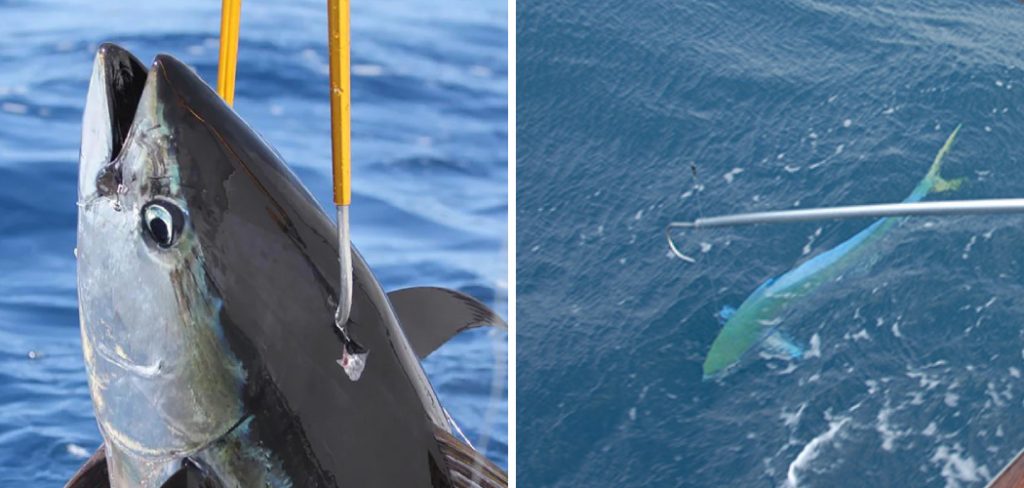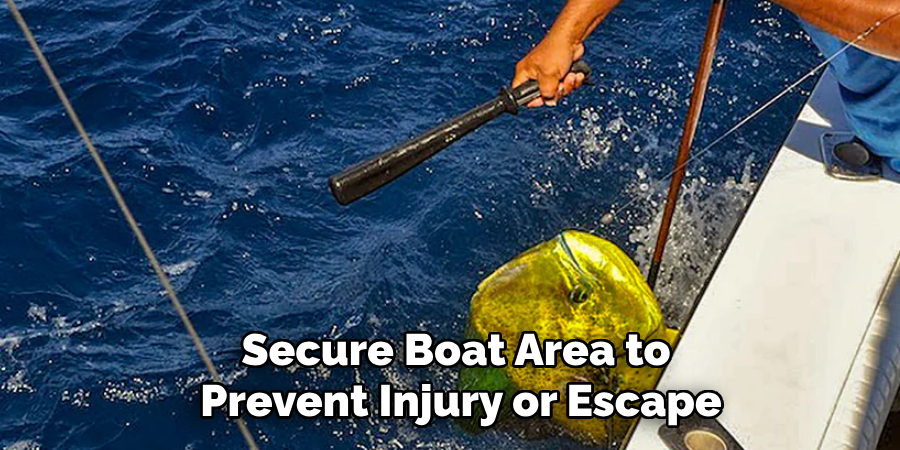Are you tired of losing your catch while fishing? Or are you struggling to pull in a large fish without breaking your fishing line? It may be time to add a fishing gaff to your angling arsenal.
How to use a fishing gaff is an essential skill for anglers aiming to safely and effectively secure a catch. A gaff is a long pole with a sharp hook or prong at the end, designed to assist in landing large fish that might otherwise be difficult to bring aboard. Proper technique and understanding of when and how to use a gaff are crucial for the angler’s safety and for ensuring a successful catch.

This guide will provide an overview of the steps and considerations involved in mastering the use of a fishing gaff.
What Are the Benefits of Using a Fishing Gaff?
Using a fishing gaff offers several benefits that can significantly improve your angling experience:
- Increased Control and Stability: A gaff provides more stability and control when landing a large fish than using only your hands or a net.
- Improved Safety: When catching larger fish, there is always the risk of injury to yourself or others. A gaff allows you to keep a safe distance from the fish while securing it.
- Reduced Damage to the Catch: Using a gaff reduces the chances of causing harm or injury to the fish, as its weight is distributed more evenly along the body than just on the line.
- Saves Time and Energy: With a gaff, you can quickly and efficiently land large fish without exerting too much energy or taking up too much time.
Now that we understand the benefits of using a fishing gaff let’s learn how to use it correctly.
What Will You Need?
Before you begin, make sure you have the following items ready:
- A Fishing Gaff: Choose a sturdy handle and sharp hook or prong.
- Heavy-duty Gloves: These will protect your hands from any potential injury caused by the fish’s fins, teeth, or hooks.
- A Landing Net: This can be a backup if the gaff fails to secure the fish.
Once you have these items, it’s time to learn how to use a fishing gaff.

9 Easy Steps on How to Use a Fishing Gaff
Step 1. Position Yourself Properly:
Start by ensuring a clear and stable position on your boat or the fishing platform. Stability is key, as using a fishing gaff can be dangerous if you’re off balance. Stand with your feet shoulder-width apart to maintain a firm stance, and keep your body aligned to face the water where the fish is being reeled in. Avoid unnecessary movements, as sudden shifts can make you lose balance, especially on a rocking boat. Always stay alert and prepared, as timing is crucial when using a gaff. Position yourself close enough to the edge to reach the fish easily but not so close that you risk falling into the water.
Step 2. Prepare the Gaff:
Ensure the gaff is securely in your hand with a firm grip on the handle. Check that the hook is sharp and free from obstructions like seaweed or debris, as this could hinder its effectiveness. Hold the gaff with the hook facing downward and ready to strike when the fish is in position. Be mindful of your surroundings to avoid accidentally hooking yourself or others while handling the gaff.
Step 3. Gaff the Fish:
When the fish is close and properly aligned, use a swift and deliberate motion to hook it with the gaff. Aim for a sturdy part of the fish, such as behind the head or along the body, avoiding softer areas that may tear. Pull the fish upward and toward the boat in one smooth motion to reduce the risk of it escaping. Keep your grip firm and steady as you lift the fish out of the water, ensuring control until it is safely onboard. Always prioritize safety and precision during this step.
Step 4. Secure the Fish:
Once the fish is onboard, carefully place it in a safe and secure boat area to prevent injury or escape. If you plan to keep the fish, quickly and humanely dispatch it using a proper method, such as a fish bat or spike, to minimize suffering. For catch-and-release, handle the fish as gently and briefly, avoiding contact with its gills while removing the hook. Ensure the fish is returned to the water promptly and in good condition. Properly securing or releasing the fish ensures responsible and ethical fishing practices.

Step 5. Clean and Store the Fish:
If you intend to keep the fish for consumption, it’s essential to clean and store it properly to preserve its freshness. Begin by rinsing the fish with clean water to remove debris or slime. Proceed to gut the fish by making a clean incision along its belly from the anal fin to the base of the gills, carefully removing the internal organs. Rinse the cavity thoroughly and pat the fish dry with a clean cloth or paper towel. Store the fish on ice or in a cooler immediately to maintain its quality and flavor. Proper cleaning and storage ensure the fish remains safe and enjoyable to eat.
Step 6. Cook the Fish:
Cooking your freshly caught fish is the final and most rewarding step. There are numerous ways to prepare fish, depending on your preferences and the species you’ve seen. Popular methods include grilling, baking, frying, or steaming. Before cooking, season the fish with your desired herbs, spices, or marinades to enhance its flavor. Ensure the fish is cooked thoroughly to an internal temperature of 145°F (63°C) to ensure it is safe to eat. Serving your prepared fish with complementary sides like vegetables or rice can elevate the meal. Cooking your catch allows you to savor the fruits of your fishing efforts.
Step 7. Cleaning Up After Cooking:
After enjoying your delicious meal, it’s essential to clean up properly to maintain a safe and hygienic kitchen. Start by washing all utensils, cutting boards, and cookware used in the preparation and cooking process with hot, soapy water. Disinfect surfaces that came into contact with raw fish to prevent cross-contamination. Dispose of fish scraps responsibly by sealing them in a bag and placing them in the garbage, or use them in compost if appropriate. Proper cleanup ensures your kitchen is ready for the next culinary adventure and helps minimize unpleasant odors.
Step 8. Storing Leftovers:
If you have any leftover cooked fish, storing it properly is crucial to maintain its freshness and safety. Allow the fish to cool to room temperature before placing it in an airtight container. Store it in the refrigerator and consume it within 2 to 3 days to ensure optimal flavor and texture. If you plan to keep it longer, consider freezing the leftovers. When freezing, wrap the fish tightly in plastic wrap or aluminum foil and place it in a heavy-duty freezer bag. Proper storage extends the life of your meal while retaining its quality and prevents food waste.
Step 9. Reheating Leftovers:

When reheating leftover cooked fish, it’s essential to do so gently to preserve its texture and avoid overcooking. For best results, use the oven by wrapping the fish in foil and reheating it at a low temperature, around 275°F (135°C), until warmed through. Alternatively, you can use a skillet over low heat with a splash of water or broth to maintain moisture. Avoid using a microwave if possible, as it can cause the fish to become dry and rubbery. Always ensure the fish reaches an internal temperature of 165°F (74°C) for safe consumption. Reheating with care will allow you to enjoy your meal as though it were freshly prepared.
By following these steps, you can successfully gaff a fish and enjoy it as a delicious meal.
5 Things You Should Avoid
- Using Excessive Force: Avoid using unnecessary strength when handling the gaff. Excessive force can damage the fish, potentially ruining the meat or causing it to escape.
- Improper Gaff Placement: Never aim for the head or vital organs when using a gaff. Proper placement ensures minimal waste and increases the chances of successfully landing the catch.
- Lack of Proper Grip: Mishandling the gaff can lead to accidents or failed attempts. Always maintain a secure and comfortable grip when maneuvering the tool.
- Using a Dull Gaff: A not sharp gaff can slip off the fish or make the process more difficult. Regularly check and maintain the gaff to ensure its effectiveness.
- Neglecting Safety Precautions: Always be mindful of your surroundings and avoid swinging the gaff recklessly. This ensures your and others’ safety on the boat.

Conclusion
How to use a fishing gaff effectively requires skill, precision, and attention to safety.
By practicing proper techniques, such as aiming for optimal placement and maintaining a secure grip, anglers can improve their chances of a successful catch while minimizing harm to the fish. Regularly inspecting and sharpening the gaff ensures it remains an efficient tool while adhering to safety precautions to protect everyone on board.
A fishing gaff can be an invaluable asset for any fishing expedition with the right approach and care.
About the Author
Jennifer Branett is the author of Fishy Kayak and an expert in fish-related fields, with over 10 years of experience. Her work blends passion for fishing with a commitment to conservation.
Educational Background
Degree: Bachelor’s in Marine Biology
Institution: University of California, Santa Barbara
Specializations: Aquatic ecosystems, fish behavior, and sustainable practices
Professional Experience
Conservation Projects:
Collaborated with local organizations to restore aquatic habitats
Developed educational programs on sustainable fishing practices
Publications:
Authored articles for fishing magazines and environmental journals
Featured speaker at fishing expos and conservation conferences
Key Areas of Expertise
Fishing Techniques:
Kayak fishing strategies
Freshwater and saltwater fishing methods
Environmental Stewardship:
Advocacy for sustainable fishing
Promoting biodiversity in aquatic environments
Awards and Recognition
Recipient of the [Specific Award Name] for contributions to marine conservation
Recognized as a leading voice in the fishing community by [Organization/Publication Name]
Community Engagement
Workshops and Seminars:
Regularly hosts events to educate anglers on sustainable practices
Engages with youth programs to inspire the next generation of fishers
Online Presence:
Maintains an active blog sharing tips, stories, and conservation efforts
Engages with followers on social media to promote fishing ethics
Personal Interests
Enjoys kayaking in scenic locations
Passionate about photography, capturing the beauty of nature
Advocates for local conservation efforts in her community
